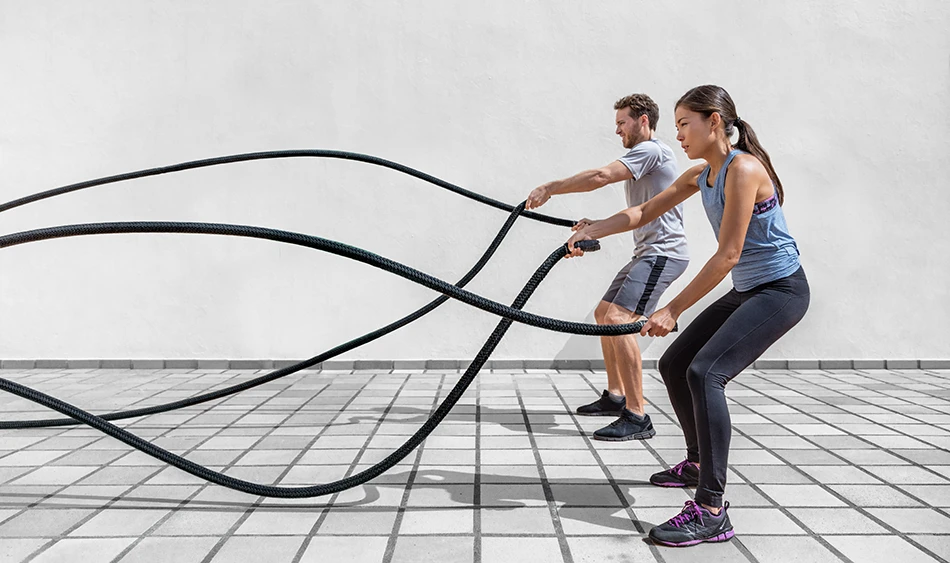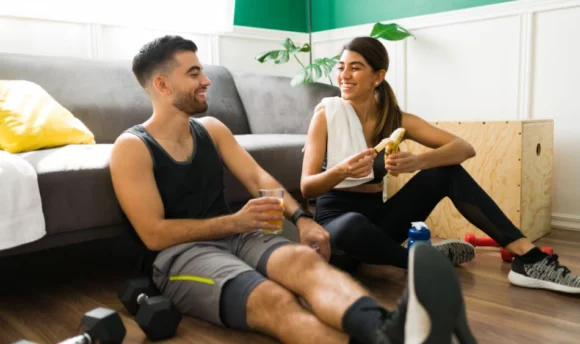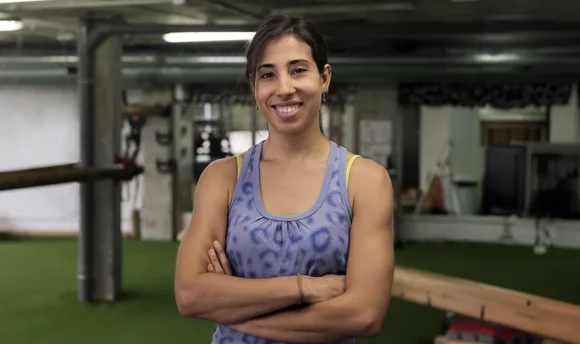Learning to Love Cardio: Benefits and Best Exercises for Every Fitness Level
Trying to tone up, improve your mental health, or simply get your body moving more? Find out how you can achieve these goals by making cardio an enjoyable part of your weekly routine.

When considering cardio, the first thing that often springs to mind is an athlete who spends hours on the treadmill. However, cardio isn’t reserved for experienced marathon runners but should be performed by individuals of all ages, abilities, and fitness levels as part of a healthy lifestyle.
If you’re worried about fitting this type of exercise into your daily routine, don’t panic. From running and biking to dancing and cross-country skiing, there are a variety of different types of cardio you can try to find the one that you enjoy the most.
Read on to discover the health benefits of cardio and how to choose the best type for you.
What Is Cardio?
Cardio is a shortened version of the word “cardiovascular,” which refers to your heart. As a type of exercise, cardio, or aerobic exercise, is any coordinated physical movement that raises your heart rate for an extended period.
This means that during cardio, your breathing will be much heavier and faster than usual, so there’s more oxygen for the heart to pump around your body. As suggested by the name, cardiovascular exercise strengthens your heart, your lungs, and improves your overall health.
How to measure your cardio fitness
If you’re hoping to improve your cardiovascular fitness, you should check your resting heart rate (RHR). For an average adult, a normal RHR is somewhere between 55 and 85 beats per minute. Throughout your fitness journey, you can then compare your results and see how much progress you’ve made.
Calculate your RHR by counting your heartbeat for 60 seconds, which you can do by finding the pulse on your arm using your index and middle finger. Rest for 10 minutes before measuring so that your RHR is as accurate as possible.
You may also measure your VO2 max, which simply refers to the maximum amount of oxygen your body can use during exercise. The higher your VO2 max, the more effectively your body can use oxygen to generate energy, which indicates that you have a good amount of cardio fitness.
This can be measured by a doctor or personal trainer, who may ask you to complete a simple walk/run test on a treadmill. Your score will depend on factors such as age, gender, and fitness level.
7 Health Benefits of Cardio Exercises
Whether you’re performing cardio to help meet your fitness goals, to lose weight, or simply to get your body moving more, this type of exercise offers a variety of health benefits. Read on to discover what these are.
#1 For your heart health
In the long run, completing more cardio means that your heart won’t have to work so hard all of the time. As a result, regular cardiovascular exercise has been shown to lower your resting heart rate, blood pressure, and blood fats while also boosting levels of “good” HDL cholesterol.
Having a stronger heart and lower resting heart rate means that the muscle doesn’t have to work as hard, which keeps it healthier over time.
#2 For your mental health
Ever heard of the phrase “runner’s high”? This actually extends to all forms of cardio exercise, which triggers the release of endorphins. These are chemicals, such as serotonin, dopamine, and norepinephrine, that lift your mood and fight any stress you may be experiencing.
#3 For life expectancy
Along with improving your day-to-day health, several studies suggest that completing regular cardio can boost your life expectancy.
It may also lower your risk of developing neurodegenerative diseases such as dementia, which lead to a decline in brain function as you age.
#4 For your physical well-being
During cardiovascular exercise, your muscles are forced to work harder to keep your whole body moving. If you continue working out with a regular and consistent cardio routine, eventually, they’ll adapt to the increased workload, helping the muscles grow in size and strength.
This includes the muscles that control digestion, which helps food move more efficiently through the digestive tract. As cardio also strengthens the lungs, you’re less likely to suffer from shortness of breath caused by chronic lung conditions like asthma.
Along with resistance training, cardio strengthens your bones and joints, which reduces your risk of developing osteoporosis, a condition that causes bones to break easily.
Furthermore, regular physical activity has many benefits for blood sugar, lowering stress on the pancreas and reducing your risk of developing type 2 diabetes. You may also be able to fall asleep faster and get more high-quality rest.
#5 For weight loss
The more you move your body, the more calories you’ll burn. When combined with a calorie-controlled diet, you’ll therefore be in a caloric deficit which, over time, helps you burn body fat and drop those pesky pounds.
#6 For your immune system
The combination of increased blood flow, lower stress levels, and better sleep helps to boost your immunity, meaning that your body becomes better at fighting off infection. If you do get sick, some studies suggest that performing a small amount of low-intensity cardio can help you recover faster and reduce symptoms.
#7 For your skin
Cardio increases the rate at which blood and oxygen reach cells within the body, including the skin cells on your face. This reduces the signs of aging, such as wrinkles and fine lines, leaving your skin looking fresh, glowy, and youthful.
Performing cardio is also a great stress buster, which reduces your risk of developing stress-related skin conditions like acne and eczema.
Types of Cardio Exercises
Cardio doesn’t just refer to one form of exercise – there are many different activities you can choose from, no matter your age or ability level.
#1 Brisk walking
Brisk walking is more intense than leisurely walking but slower than jogging. This activity is a great way to increase your calorie burn and test your cardiovascular fitness, with less impact on your joints than running.
To complete a brisk walk, you should be moving at 3 miles per hour or faster, which counts as moderate exercise.
#2 Running
Having a regular running schedule helps your heart and lungs become stronger while also building strength in your quads, glutes, and calves.
There are several things that you need to consider if you’re a running beginner, including purchasing appropriate gear, building a gradual training plan, and working on your technique.
#3 Cycling
Studies show that commuting by bicycle reduces your risk of cardiovascular disease, along with cancer and all-cause mortality. Cycling regularly also helps strengthen the lower body muscles, including those in the legs, glutes, and hips.
For beginners, it’s recommended to cycle at a steady pace of 12 miles per hour, which should feel relatively easy even if it’s your first time on a road bike.
#4 Elliptical
Often found in the gym, the elliptical trainer is a piece of equipment that requires you to move your legs and arms back and forth. This is a low-impact form of exercise that mimics a skating or skiing movement and is significantly less weight-bearing than other forms of cardio like running.
#5 Rowing
Rowing is another low-impact activity, making it a good choice for those looking to burn calories without putting stress on the joints. It is also a great full-body workout, which consists of 65–75% leg work and 25–35% upper body work, according to the American Fitness Professionals Association.
If you are a beginner rowing to lose weight, use medium-intensity resistance and aim to perform 25–30 strokes per minute for around 20–30 minutes.
#6 Climbing
Rock climbing not only provides a huge sense of accomplishment but is also a great way of increasing grip strength across your whole body. This includes the latissimus dorsi or “lats” muscles in your back, forearm muscles, abdominals, and quadriceps.
You’ll also build your balance and coordination, along with cardiovascular fitness and confidence levels too.
#7 Circuit training
During circuit training, you’ll rotate between 8 and 10 cardio and strength training exercises with minimal rest between each, and repeat the circuit 1–3 times.
This type of training helps to increase your muscular and cardiovascular endurance, as you’ll be performing a high number of reps. Over time, this means that you’ll be able to exercise for longer without becoming tired.
#8 HIIT
High-intensity interval training is a type of vigorous-intensity exercise that involves short intervals alternated with brief rest periods. For example, you may exercise for 20 seconds, followed by 10 seconds of rest, before repeating the cycle.
What’s great about HIIT is that you can burn a lot of calories and build your aerobic fitness in a short period, which is ideal for those looking to see fast results for a stronger heart. You’ll also continue burning calories for hours after completing the session, boosting your metabolism and helping with weight loss in the long term.
#9 Swimming
Swimming is a low-impact form of cardio, which is ideal for those who experience lower-body joint pain. It may be less intense, but swimming offers many of the same benefits for your cardiovascular system as other forms of exercise, such as increasing your heart rate and boosting lung capacity.
Performing moderate swimming laps for one hour can burn around 400–500 calories, depending on your age, gender, and current weight. Try swimming at least 4 days per week if you’re hoping for visible weight loss results.
#10 Cross-country skiing
Cross-country skiing is an exciting type of cardio for those wanting a more adventurous activity. Navigating a snow-covered mountain requires your full body strength, and research suggests that those who take part in this sport have higher levels of aerobic fitness than in any other form of skiing.
As a beginner, you should take skiing lessons from a professional to begin with, who can teach you the correct lower-body movements to propel yourself forward safely and effectively.
#11 Strength training
Strength training requires your body to work against a form of external resistance, such as a barbell, dumbbell, resistance band, or even your own body weight.
To improve your cardiovascular fitness along with muscular strength, strength training exercises such as lunges, squats, and push-ups can be performed back-to-back, with little rest. Perform each exercise for 8–10 reps, for 3–4 sets, before moving on to the next.
You could also choose lighter weights and perform 12–15 reps per set to elevate your heart rate and burn more calories.
How to Choose Cardio Exercises for Your Level
If you’re a beginner, it’s important to choose a type of exercise that you’ll enjoy if you hope to stick to it in the long term. You should also gradually build up the exercise intensity to prevent becoming burnt out or getting injured.
One way of ensuring that you’ve selected the right exercise for your ability is using the RPE scale. Meaning rate of perceived exertion or effort, RPE refers to a person’s capacity for exercise and can be measured using the Borg Category Ratio Scale (CR10) as shown below.
| Rate of perceived exertion (RPE) rating | Effort felt |
| 1 | Very easy |
| 2 | Easy |
| 3 | Moderate |
| 4 | Somewhat hard |
| 5 | Hard |
| 6 | – |
| 7 | Very hard |
| 8 | – |
| 9 | Extremely hard |
| 10 | Maximal effort |
You should aim for an RPE of between 3 and 7 when exercising from home, which indicates a moderate to vigorous intensity of exercise.
How long should a cardio workout last?
To gain the benefits of cardio, it’s recommended to perform at least 150 minutes of moderate-intensity exercise or 75 minutes of vigorous-intensity exercise per week. If you’re fairly new to cardio, then stick to a moderate intensity, which will allow your body time to get used to the movements.
This means that you could do five 30-minute workouts that raise your heart rate per week, with 2 days for rest and recovery.
8 Best Cardio Exercises to Do At Home
The following calorie-burning exercises require no equipment, and you can complete them from the comfort of your own home or on the go. Try putting them together to form your own exercise program.
Perform one exercise for 45 seconds to 1 minute, rest for 30 seconds, and then repeat the exercise again for 3–4 sets. If you are completely new to cardio, perform each exercise for 20–30 seconds to start with, and gradually build up the exercising periods as you become fitter.
#1 Burpees
Burpees use your own body weight as a form of resistance to work against, which helps to strengthen muscles in your lower body, abdomen, shoulders, and chest. It is also a high-intensity exercise that helps to boost calorie burn and test your endurance levels.
The standard version is called the chest-to-floor burpee, but a simpler variation is the half burpee. Rather than lying completely on the floor, you can simply return to a push-up position. You can also remove the jump until your cardiovascular fitness has increased.
#2 Squat jumps
Performing squat jumps is a great way of increasing the cardiovascular intensity of a regular squat, which targets all of the main muscle groups in the legs, including the quadriceps, glutes, hamstrings, and calves.
Beginners should nail the squat movement before adding a jump, and those with more experience can perform more reps at a faster pace.
#3 Jumping jacks
Jumping jacks are a plyometric, or explosive, exercise, and practicing them regularly can help you to develop more power, run faster, and lift heavier.
Simplify the exercise by using only the legs, which is ideal if you are finding it difficult to coordinate your arms and legs together. Increase the intensity of the exercise by jumping faster or higher.
#4 Mountain climbers
Mountain climbers are another type of explosive exercise that uses your body weight to improve coordination and full body strength. When performed quickly, they can also get your heart pumping and help to burn calories.
Perform this movement slowly if you’re a beginner, or switch your legs quickly for more intensity.
#5 High knees
High knees are a simple yet effective running on-the-spot exercise that can be used as a warm-up, part of a HIIT workout, or as a burst of energy in a strength training circuit.
Once you’ve nailed the movement, you can increase the intensity by running faster to improve your cardio fitness levels even further.
#6 Jump rope
Jump rope works as a great full-body cardio workout for adults and kids alike, helping to build strength in your quads and calves while also increasing calorie burn. This exercise can be performed with a real or imaginary jump rope, depending on your equipment and fitness level.
Make this a more difficult exercise by jumping from one foot to the other, performing single-leg hops, or trying double unders where you jump over the rope twice in one rotation.
#7 Jumping lunges
Also known as screamer lunges due to their intensity, jump lunges challenge your balance, coordination, and core strength while helping to build the quadriceps.
Beginners should try to master the lunge movement before adding a jump, while those with more experience can alternate between the left and right leg or perform more reps.
#8 Dancing
From hip-hop and ballet to simply enjoying yourself with friends at a party, dancing is a fun form of cardiovascular exercise that provides an easy and accessible way for people of all ages and abilities to get fit.
Not only will you burn more calories the longer you dance, but you’ll also strengthen your muscles, develop better coordination, and reduce your risk of weak bone conditions such as osteoporosis. Plus, your confidence levels and general well-being will be much higher.
7 Useful Tips for Doing Cardio Workouts
No matter the type of cardio you choose, there are certain considerations that you should make to ensure that you’re performing each exercise safely and effectively. Here are 7 tips to help you get the most from your cardiovascular workouts:
- Complete a warm-up – You should always spend 5–10 minutes before your workout performing dynamic stretches, which prepare the muscles for vigorous exercise, reduce your risk of injury, and may even improve your performance.
- Finish your workout with a cool-down – Complete static stretches during your cool-down, as they promote recovery. They may also increase muscle strength and power while helping your blood pressure and heart rate return to normal levels.
- Gradually increase your workout intensity – As a beginner, you shouldn’t make your workouts too intense as this could lead to injury. However, if you’re hoping to see improvements in your cardiovascular fitness, the exercises you select should be challenging.
- Choose a safe exercise space – To prevent injury, ensure that you have a space large enough in your home to move freely. Wear slip-proof shoes on hard floors, and remove rugs to reduce your risk of tripping over.
- Use a fitness app – Apps will provide you with the guidance and motivation you need to reach your cardiovascular goals. A great example is Joggo, a running app that creates an exercise program personalized to your needs and goals.
- Find workouts online – Streaming services like YouTube have thousands of videos that offer inspiration from qualified personal trainers and organizations, including the National Academy of Sports Medicine.
- Drink plenty of water – To replace any water you lose through sweat, it’s also important to stay hydrated before, during, and after working out.
FAQs
The best cardio exercise is the one that you enjoy the most and that you’ll perform regularly. Running generally burns the most calories per hour, whereas high-intensity interval training burns more calories in a shorter period of time.
You should perform 150 minutes of moderate-intensity exercise per week, or 75 minutes if you’re exercising at a more vigorous intensity. Five 30-minute moderate-intensity cardio sessions should be enough to maintain a healthy heart, although this will vary from person to person.
HIIT is one of the best workouts, as it boosts your metabolism and allows you to continue burning calories for hours after your workout has ended.
A Word From a Personal Coach
Although practicing cardio regularly and with intensity is essential if you’re hoping to improve your cardiovascular health, performing each movement with the proper form is important for a safe and effective workout. Whether you’re looking to lose weight or build muscle, you should also prioritize eating a healthy, balanced diet to meet your fitness goals.
Eating foods that are high in protein will keep you feeling fuller for longer while also supporting muscle growth and repair. Whole-grain, fiber-rich carbohydrates are vital for maintaining energy levels too. You could also add some supplements into your diet, which can help to improve your running or overall fitness performance.
Before beginning any new exercise program, you should always consult a healthcare professional, particularly if you have an existing medical condition.
Conclusion
Whether you’re hoping to lose weight, boost your life expectancy, or feel more confident in your own skin, there is a wide range of cardio workouts to help all shapes, sizes, and experience levels meet their goals.
Start with short, moderate-intensity workouts and gradually increase the difficulty as you get fitter. It’s important to always pay close attention to your body and stop exercising immediately if you experience any pain.

















































 Select your language:
Select your language: 








